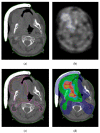FMISO-Based Adaptive Radiotherapy in Head and Neck Cancer
- PMID: 36013194
- PMCID: PMC9410424
- DOI: 10.3390/jpm12081245
FMISO-Based Adaptive Radiotherapy in Head and Neck Cancer
Abstract
Concurrent chemoradiotherapy represents one of the most used strategies in the curative treatment of patients with head and neck (HNC) cancer. Locoregional failure is the predominant recurrence pattern. Tumor hypoxia belongs to the main cause of treatment failure. Positron emission tomography (PET) using hypoxia radiotracers has been studied extensively and has proven its feasibility and reproducibility to detect tumor hypoxia. A number of studies confirmed that the uptake of FMISO in the recurrent region is significantly higher than that in the non-recurrent region. The escalation of dose to hypoxic tumors may improve outcomes. The technical feasibility of optimizing radiotherapeutic plans has been well documented. To define the hypoxic tumour volume, there are two main approaches: dose painting by contour (DPBC) or by number (DPBN) based on PET images. Despite amazing technological advances, precision in target coverage, and surrounding tissue sparring, radiation oncology is still not considered a targeted treatment if the "one dose fits all" approach is used. Using FMISO and other hypoxia tracers may be an important step for individualizing radiation treatment and together with future radiomic principles and a possible genome-based adjusting dose, will move radiation oncology into the precise and personalized era.
Keywords: FMISO; adaptive radiotherapy; head and neck cancer.
Conflict of interest statement
The authors declare no conflict of interest.
Figures

References
-
- Bennardo L., Bennardo F., Giudice A., Passante M., Dastoli S., Morrone P., Provenzano E., Patruno C., Nisticò S. Local Chemotherapy as an Adjuvant Treatment in Unresectable Squamous Cell Carcinoma: What Do We Know So Far? Curr. Oncol. 2021;28:2317–2325. doi: 10.3390/curroncol28040213. - DOI - PMC - PubMed
-
- Koukourakis M.I., Giatromanolaki A., Sivridis E., Pastorek J., Karapantzos I., Gatter K.C., Harris A.L. Hypoxia-activated tumor pathways of angiogenesis and pH regulation independent of anemia in head-and-neck cancer. Int. J. Radiat. Oncol. Biol. Phys. 2004;59:67–71. doi: 10.1016/j.ijrobp.2003.10.016. - DOI - PubMed
Publication types
LinkOut - more resources
Full Text Sources

